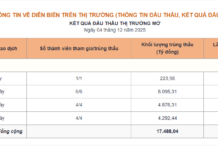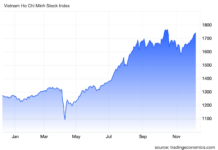
According to the Statistical Yearbook 2022, the average per capita income of the whole country is about 4.67 million VND, an increase of 11.1% compared to 2021. The highest income group earns 10.23 million VND per month, while the lowest is 1.35 million VND, a difference of 7.6 times.
The provinces in the North Central and upland region have the highest income disparity in the country (8.8 times), followed by the Central Highlands (8.1 times), the North Central and Central Coast (6.6 times), and the Mekong Delta (6.3 times). The lowest income disparity is in the Southeast (5.5 times) and Red River Delta (5.8 times).
In terms of provinces, Cao Bang has the largest income gap between the highest and lowest income groups in the country. High-income earners in Cao Bang make 6.4 million VND per month, while low-income earners make only 524,000 VND, a difference of 12.2 times. The next provinces are Bac Kan (11.7 times), Quang Tri and Tra Vinh (9 times), Son La and Ha Giang (8.9 times), Lao Cai (8.8 times),…
Thai Binh has the smallest income gap – 3.6 times. The high-income group in this province earns an average of 7.89 million VND per month, while the remaining group earns 2.18 million VND. The provinces with low income disparity are Binh Thuan (3.9 times), Ho Chi Minh City (4.5 times), Dong Thap, Bac Giang, and Hung Yen (4.8 times).
The 5 centrally-run cities, Hanoi, Ho Chi Minh City, Hai Phong, Da Nang, and Can Tho, have income disparities of Hanoi (6.5 times), Ho Chi Minh City (4.5 times), Hai Phong (5.2 times), Da Nang (5.3 times), and Can Tho (6 times).
According to the statistics, the region with the highest per capita income is Southeast Region (6.33 million VND/person/month), 2.2 times higher than the region with the lowest per capita income, which is the North Central and upland region (3.17 million VND/person/month).
The average monthly per capita expenditure in current prices for the whole country in 2022 was 2.8 million VND, a decrease of 3.3% compared to 2020, in which the average monthly per capita expenditure in rural areas was 2.5 million VND, an increase of 4.6%; urban areas reached 3.3 million VND, a decrease of 13.6%. The expenditure structure has not changed significantly compared to previous years. The proportion of expenditure for daily life in the average monthly per capita expenditure in 2022 accounted for 95.5%, and other expenditures accounted for 4.5%.
According to the recent report from the General Statistics Office, in 2023, Vietnam has an unemployment potential of 2.3 million people. The unemployment rate for 2023 is 4.3%.
The unemployment potential rate is a comprehensive indicator that shows the imbalance between labor supply and demand in the labor market; reflecting the surplus of labor. Under normal economic development conditions, the unemployment potential rate always exists and tends to increase when the market undergoes economic and social shocks.
Vietnam’s unemployment potential rate usually fluctuates at 4%. In the period from the first quarter of 2020 to the second quarter of 2022, this rate reached a record high of 10.4% in the third quarter of 2021 and then gradually decreased and maintained at 4.2%. By the fourth quarter of 2023, this rate was 4.2% (equivalent to more than 2.2 million people).
Overall, in 2023, the number of people with unemployment potential is 2.3 million, a decrease of nearly 0.3 million compared to the previous year. The unemployment potential rate for 2023 is 4.3%, a decrease of 0.6 percentage points compared to 2022. This rate is 4.3% for both urban and rural areas.





































